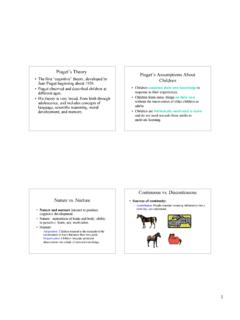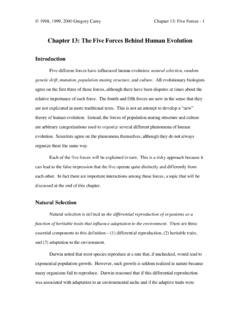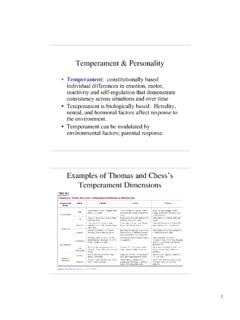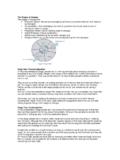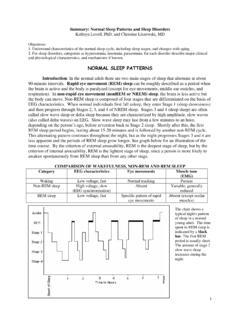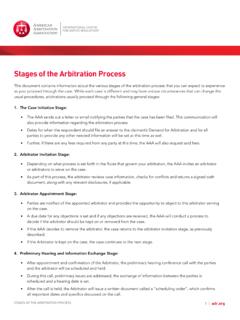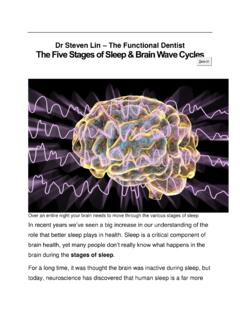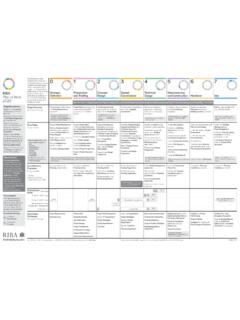Transcription of Piaget’s Theory
1 1 piaget s Theory The first cognitive Theory , developed byJean piaget beginning about 1920. piaget observed and described children atdifferent ages. His Theory is very broad, from birth throughadolescence, and includes concepts oflanguage, scientific reasoning, moraldevelopment, and s Assumptions AboutChildren Children construct their own knowledge inresponse to their experiences. Children learn many things on their ownwithout the intervention of older children oradults. Children are intrinsically motivated to learnand do not need rewards from adults tomotivate vs.
2 Nurture Nature and nurture interact to producecognitive development. Nature: maturation of brain and body; abilityto perceive, learn, act; motivation Nurture: Adaptation: Children respond to the demands of theenvironment in ways that meet their own goals. Organization: Children integrate particularobservations into a body of coherent vs. Discontinuous Sources of continuity: Assimilation: People translate incoming information into aform they can vs. Discontinuous Sources of continuity: Assimilation: People translate incoming information into aform they can understand.
3 Accommodation: People adapt current knowledgestructures in response to new vs. Discontinuous Sources of continuity: Assimilation: People translate incoming information into aform they can understand. Accommodation: People adapt current knowledgestructures in response to new experience. Equilibration: People balance assimilation andaccommodation to create stable understanding4 Sources of discontinuity: There are distinctstages of cognitive development, with thefollowing properties. Qualitative change : Children of different ages (and atdifferent stages) think in different ways.
4 Broad applicability: The type of thinking at each stagepervades topic and content areas. Brief transitions: Transitions to higher stages ofthinking are not necessarily continuous. Invariant sequence: The sequences of stages are stablefor all people through all time. Stages are not vs. DiscontinuousPiaget s Stages Sensorimotor stage (birth to 2 years) Knowledge develops through sensory and s Stages Sensorimotor stage (birth to 2 years) Preoperational stage (2 to 7 years) Knowledge is represented by language, mental imagery,and symbolic s Stages Sensorimotor stage (birth to 2 years) Preoperational stage (2 to 7 years) Concrete operational stage (7 to 12 years) Children can reason logically about concrete objects and s Stages Sensorimotor stage (birth to 2 years)
5 Preoperational stage (2 to 7 years) Concrete operational stage (7 to 12 years) Formal operational stage (12 years and up) Children can think deeply about concrete eventsand can reason abstractly and s Sensorimotor stage Substage 1 (birth to 1 month) Building knowledge through reflexes (grasping,sucking).7 piaget s Sensorimotor stage Substage 1 (birth to 1 month) Substage 2 (1 to 4 months) Reflexes are organized into larger, integrated behaviors(grasping a rattle and bringing it to the mouth to suck). piaget s Sensorimotor stage Substage 1 (birth to 1 month) Substage 2 (1 to 4 months) Substage 3 (4 to 8 months) Repetition of actions on the environment that bring outpleasing or interesting results (banging a rattle).
6 8 piaget s Sensorimotor stage Substage 1 (birth to 1 month) Substage 2 (1 to 4 months) Substage 3 (4 to 8 months) Substage 4 (8 to 12 months) Mentally representing objects when objects can nolonger be seen, thus achieving object permanence. piaget s Sensorimotor stage Substage 1 (birth to 1 month) Substage 2 (1 to 4 months) Substage 3 (4 to 8 months) Substage 4 (8 to 12 months) Substage 5 (12 to 18 months) Actively and avidly exploring the possible uses towhich objects can be put: Banging a spoon or cup onhigh chair to make different sounds, get stage Substage 1 (birth to 1 month) Substage 2 (1 to 4 months) Substage 3 (4 to 8 months) Substage 4 (8 to 12 months) Substage 5 (12 to 18 months) Substage 6 (18 to 24 months) Able to form enduring mental representations, asdemonstrated by deferred imitation, the repetition ofothers behaviors minutes, hours, or days after it stage Symbolic representations - the use of oneobject to stand for another.
7 Egocentrism: Looking at the world only fromone s own point of view. Centration: Focusing on one dimension ofobjects or events and on static states ratherthan Operations stage Conservation concept - changing theappearance or arrangement of objects does notchange their key properties. Highly abstract thinking and reasoning abouthypothetical situations still remains Concepts12 Ability to think abstractlyand reasonhypothetically. Ability to reasonsystematically about alldifferent outcomes. Ability to engage inscientific Operations StageStagesSensorimotorBirth 2 yearsUnderstands world through senses andactionsPreoperational2 7 yearsUnderstandsworld throughlanguage andmentalimagesConcrete operational7 12 yearsUnderstandsworld through logicalthinking andcategoriesFormal operational12 years onwardUnderstandsworld throughhypotheticalthinking and scientificreasoning13 Criticisms of piaget s Theory Children s thinking is not as consistent as thestages suggest.
8 Infants and young children are more competentthan piaget recognized. piaget understates the social components ofcognitive development. piaget was better at describing processes thanexplaining how they operate.
